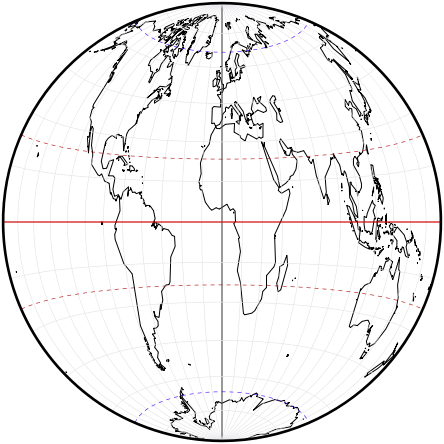dummy_index wrote: ↑Thu Jan 16, 2020 7:03 am
daan wrote: ↑Tue Jan 14, 2020 7:29 pmCould you provide the Japanese word (漢字で) for “twitch”?
It was translation of "引き攣れる".
I still can’t find an equivalent term in mathematics. The third derivative of the position vector is often called “jerk”, and the fourth derivative is sometimes called “jounce”. Those have similar everyday meanings to “twitch”. Maybe there are engineering fields that use “twitch”, but I was not able to find any. What is the mathematical principle that 引き攣れ expresses?
例えば地表を almost double hemisphere に断裂させて(100 kmだけつながった状態だとして)できた periphery を直径4 Rの円の形にしようとすると、100 kmしか離れていなかった2地点を4 R = 25,484 kmまで離さないといけないので、地図の内部で angular deformation がとても大きくなります。元々の180° meridianのみの断裂でも両極間π Rの距離を4 Rに引き伸ばすことになります
daan, as a translation, wrote:If you represent the sphere on the plane as a nearly double hemisphere, with only 100km of connection between the two near-hemispheres, then you will end up with points that were separated by a mere 100km on the sphere being separated by 4R = 25,484km equivalent on the plane. This means there must be large angular deformation within the map. Even if you only interrupt along the 180° meridian, as per the projection under discussion, the original πR distance between the poles will get extended to 4R.
Is this an argument for how to minimize the angular deformation of the boundary, or how to minimize the average angular deformation across the map? It is not clear to me that the argument necessarily achieves either one. For example, while it is possible that the circular Hammer has lower angular deformation along its boundary than my modified Eisenlohr, it definitely has higher average angular deformation.
It seems to me that your algorithm は地図の中心でconformalになっていることを前提としていて
daan, to translate, wrote:It seems to me that your algorithm presumes conformality at the map’s center;
It’s much more complicated than that. There is nothing special about the center in the general case. To transform a conformal map to an equal-area map by my algorithm, first identify the isocol that you wish to be conformal on the equal-area map. Often, such as on the modified Eisenlohr that I gave as an example, that isocol will be a single point. If I had chosen some other isocol, then, on my example map, the equal-area result would have opened a hole interior to the isocol. If the isocol you choose is closed, then the resulting equal-area map will have a hole. In order to avoid a hole, you must choose some local minimum as your conformal isocol. That local minimum may well be a path, such as the equator on a Mercator. However, for Eisenlohr, it is a single point.
If the map has several local minima that are not part of the same path, and the values of those local minima differ, then you must choose the one with the lowest value if you want to avoid all holes.
かつ地図の中心からどの方向に向かっても(azimuthal equal area や Hammer がそうであるように)径方向に圧縮されて周方向に引き伸ばされることだけを想定しているようです。
daan, to translate, wrote:furthermore, no matter which direction from the center (such as azimuthal equal-area and Hammer are), it seems like you are just assuming a radial compression and a circumferential stretch.
That is true only locally to the conformal isocol. The compression is not radial finitely. Instead, compression follows the “antisocol”, which is the path that crosses each isocol perpendicularly from the boundary to the conformal isocol, and that contains the point you want to compute.
こうなると必然的にcentral meridianは本来のnatural lengthより短く表現されることになり、circular Hammerとは違う形にならざるを得ません。その結果周長がcircular Hammerより長くなりひずみが大きくなります。
daan, to translate, wrote:Thus, the central meridian will inevitably be displayed shorter than its natural length and the shape will differ from the circular Hammer.
Yes. The circular Hammer has a central meridian that is too long. The modified EIsenlohr has a central meridian that is too short.
daan, to translate, wrote:As a result, the boundary becomes longer than the circular Hammer, and therefore the distortion is higher.
Certainly the boundary on the modified Eisenlohr is longer because the circular Hammer’s boundary is a circle, and of all shapes with the same area, a circle yields the shortest perimeter. Your assertion that this implies lower distortion along the boundary is novel to me. I have to think about it. Superficially, it sounds correct.
Do we have some sort of “compromise projection” within the domain of conformal projections?

GS50 compromises among 50 states?

Actually, GS50 is (nearly) a min/max optimization, which would be antithetical to a compromise.
Cheers,
— daan
